

How to Export Mailboxes with Exchange Server 2010 SP1. Exchange Server 2010 Service Pack 1 introduced a new method for exporting mailboxes called Mailbox Export Requests.
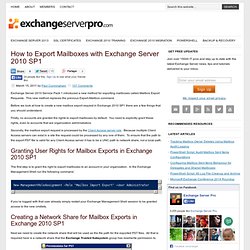
This new method replaces the previous Export-Mailbox command. Before we look at how to create a new mailbox export request in Exchange 2010 SP1 there are a few things that you should understand. Firstly, no accounts are granted the rights to export mailboxes by default. You need to explicitly grant these rights, even to accounts that are organization administrators. Secondly, the mailbox export request is processed by the Client Access server role. Granting User Rights for Mailbox Exports in Exchange 2010 SP1 The first step is to grant the right to export mailboxes to an account in your organization.
New-ManagementRoleAssignment –Role "Mailbox Import Export" –User Administrator If you’re logged with that user already simply restart your Exchange Management Shell session to be granted access to the new cmdlets. Exporter et importer un PST dans Exchange en PowerShell. Get-MailboxExportRequestStatistics. Exchange 2010 Recoverable Items folder TotalDeletedItemsSize issue! « MSExchangeGuru.com. This is a tip to address an issue where Exchange 2010 TotalDeletedItemsSize remains unaltered after trying to empty it out.
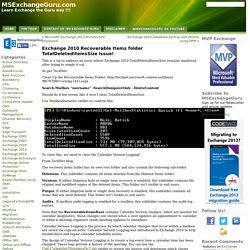
As per TechNet: Clean Up the Recoverable Items Folder: Search-Mailbox “username” -SearchDumpsterOnly –DeleteContent Should do it but seems like it won’t clear TotalDeletedItemsSize Use MailboxStatistics cmdlet to confirm this. To clear this, we need to clear the Calendar Version Logging! From TechNet blog- The recovery items folder has its own root folder and also contain the following sub-folder. Deletions: This subfolder contains all items deleted from the Deleted Items folder. Versions: If either litigation hold or single item recovery is enabled, this subfolder contains the original and modified copies of the deleted items. Purges: If either litigation hold or single item recovery is enabled, this subfolder contains all items that are hard deleted.
Audits: If mailbox audit logging is enabled for a mailbox, this subfolder contains the audit log entries. 1.) 2.) 3.) 4.) How to Export Recoverable Deleted Items and Purges folders to a PST. Get-MailboxExportRequestStatistics. Remove-MailboxExportRequest: Exchange 2013 Help. Exchange 2010 Archives - Noobs-IT. Les contacts Créer un contact Enable-MailContact -Identity "Julien BELLIRI GENTY" -Alias jbellirigenty -ExternalEmailAddress jbellirigenty@noobs-it.fr Désactiver un contact.
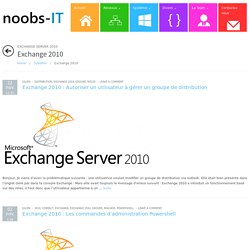
Export de boites email Exchange 2007/2010 vers PST. Exchange 2010 SP1 – Récupération d’éléments supprimés. Après avoir supprimé des messages, on peut avoir besoin de les récupérer.
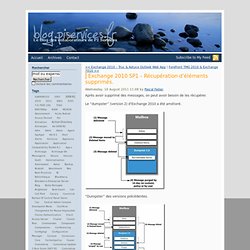
Le “dumpster” (version 2) d’Exchange 2010 a été amélioré. “Dumpster” des versions précédentes. “Dumpster” 2.0. Vérifions ce “dumpster”: Comment exporter des éléments supprimés récupérables et purge des dossiers pour un PST - AndersonPatricio.ca. Hi there folks!
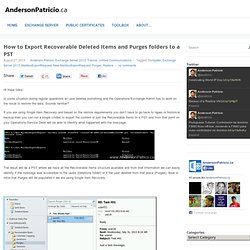
In some situation during regular operations an user deletes something and the Operations/Exchange Admin has to work on the issue to restore the data. Sounds familiar? If you are using Single Item Recovery and based on the restore requirements you don’t have to go back to tapes or historical backup then you can run a single cmdlet to export the content of just the Recoverable Items to a PST and from that point on your Operations/Service Desk will be able to identify what happened with the message. The result will be a PST where we have all the Recoverable Items structure available and from that information we can easily identify if the message was accessible to the users (Deletions folder) or if the user deleted from that place (Purges). Bear in mind that Purges will be populated if we are using Single Item Recovery.
Written by Anderson Patricio. How to Export Mailboxes with Exchange Server 2010 SP1. Exporter des boîtes aux lettres en PST sous Exchange 2010 SP1. Vous êtes ici : Accueil > Exchange 2010 30 juin 2010 Un commentaire Un grand classique pour l’administrateur Exchange, c’est d’exporter les boîtes aux lettres de ses serveurs au format PST.
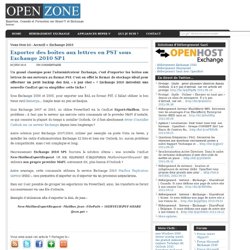
C’est en effet le format de stockage idéal pour effectuer un petit backup des BAL « à pas cher » ! Exchange 2010 introduit une nouvelle CmdLet qui va simplifier cette tâche ! Sous Exchange 2000 et 2003, pour exporter une BAL au format PST, il fallait utiliser le bon vieux outil Exmerge … Simple mais un peu archaïque.
Sous Exchange 2007 et 2010, on utilise PowerShell via la CmdLet Export-Mailbox . Autre solution pour Exchange 2007/2010, utiliser par exemple un poste Vista ou Seven, y installer les outils d’administration Exchange 32 bits et bien sur Outlook. Heureusement Exchange 2010 SP1 fournira la solution ultime : une nouvelle CmdLet New-MailboxExportRequest (et son équivalent d’importation MailboxImportRequest ) qui utilisera son propre provider MAPI , autrement dit, plus besoin d’Outlook ! Exporter une boite aux lettres vers un PST avec Powershell.
Je vous propose de découvrir dans cet article comment exporter des boîtes aux lettres (BAL) Exchange en PowerShell à l’aide de Exchange Management Shell.
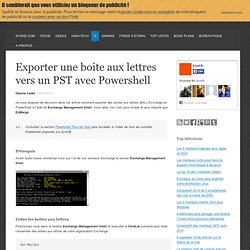
Vous allez voir c’est plus simple et plus robuste que ExMerge Consultez la section Powershell Pour les Nuls pour accédez à l’index de tous les tutoriels Powershell proposés sur SysKB.